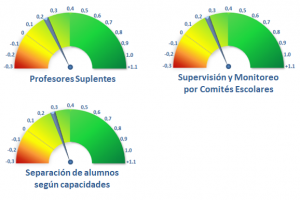Implementing institution: International Child Support (ICS)
Country: Kenya
Source: IPA
Execution period: 2005 - in progress
Plataforma de Prácticas Efectivas:
Increase student capacity by hiring substitute teachers, involving families, and classifying students by initial performance level.
Three complementary interventions to reduce teacher/student ratios, reduce heterogeneity within classes, and empower families.
The recruitment of substitute teachers has an increase of 0.22 SD on learning, while the impact is even greater when the process is supervised and monitored by School Committees (+0.25 SD), and when students are separated according to their level of ability (+0.28 SD).
Peer Effects, Pupil Teacher Ratios and Teacher Incentives is implemented by the NGO International Child Support (ICS). The initiative is understood as a comprehensive school attendance program that focuses on the structural organization of schools and modes of teaching. It includes three complementary axes: schools and modes of teaching.
The ETP program is complemented by facilities in the hiring process and the additional teacher’s obligation to report to the school’s Parent Committee, which becomes the school’s sole authority. In this sense, the ETP replaces the traditional vertical control of the teacher by their administrative superiors with a system that involves families.
Like many countries in the sub-Saharan region, Kenya is characterized by a young, rural population, with children under 14 accounting for 40% of the total population (range 15-24, 20%); 74% of all inhabitants live in rural areas. These areas are home to high levels of vulnerability, low productivity and shortages of basic services such as health and education.
In education, although the country has managed to increase the net participation of children and young people at the elementary and secondary levels, by 2012, there were one million children who did not attend the formal education system. This number dropped considerably between 2006 and 2007 (minus 44%), but returned almost to its initial levels the following year, to remain more or less stable until now. The above trends reveal a complex educational context in Kenya, which tends to worsen along with the decline, since 2006, in the proportion of public expenditure on education in relation to GDP (from 7 to 5% at present).
Between 2005 and 2007, Innovation for Poverty Action (IPA) conducted a pilot evaluation of the program to determine its impact on students’ skills. Thus, a baseline was surveyed in 2004 in 210 elementary schools in western regions of the country. 140 received the ETP intervention from 2005, while the others (70) formed the control group. Of the intervention group (A), half received the SBM program, and 25% received both the SBM and the selection of children according to abilities.
Overall, the impact of the ETP program reaches +0.22 SD. The highest results are achieved when local school committees have the capacity to oversee the process of recruiting teachers, and to effectively monitor their performance (SBM program). The conjunction of the two interventions implies 0.25 SD (against 0.19 without SBM). Also, a very significant effect of the distribution of students according to their abilities (0.28 SD, against 0.16 without selection) was highlighted.
Given that the costs of the initiative, which are mainly represented by the substitute teacher’s salary (US$ 35 per month), the program offers a good alternative for elementary schools in marginal areas.
Impact of interventions:

Charts: Impact measured in standard deviations of the intervention group compared to the control group.
Link: https://www.poverty-action.org/study/peer-effects-pupil-teacher-ratios-and-teacher-incentives
Report: Ver informe
Other documents:
Tags: